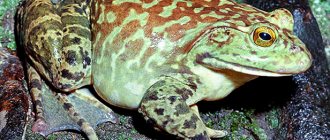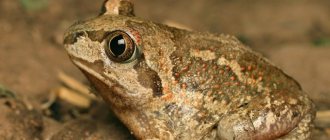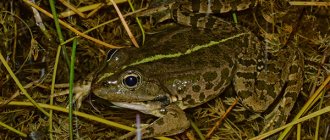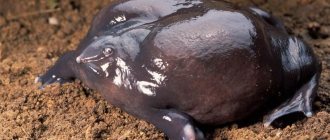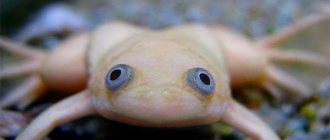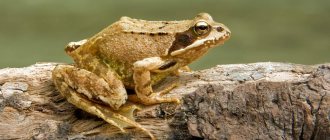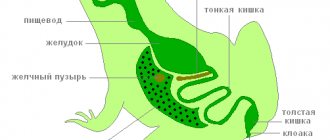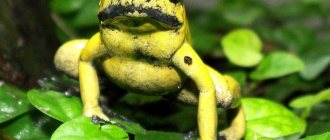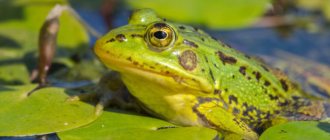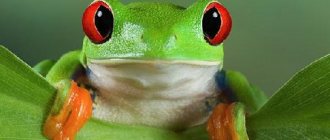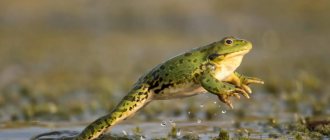- Description, structure, characteristics
Millions of years have passed since the appearance of vertebrates on land. The continents were filled with a variety of animals adapted to a wide variety of living conditions, but amphibians remained the only vertebrates that belong to both water and land. The frog, a modern representative of the amphibian class, has captured within itself the longest experience of struggle for existence in the history of life on land. This led to the universality of its anatomy and physiology, providing a unique adaptation to life in the border zone.
Reproduction
Like millions of years ago, the frog begins its life in water. Every spring you can observe in an abbreviated form the process that once led to the transformation of fish-like ancestors into land animals.
A tadpole develops from eggs laid in water. So far, it differs little from fish fry. But then a series of transformations begins, consisting of about thirty transitional stages. The last one is the main one. A week - and radical changes occur in all organs. A week - and the tadpole turns from a “fish” into a land animal. From now on, the frog will live on land, or more precisely, on the border of land and water.
Population and species status
According to scientists, an irreversible process is currently underway to reduce the total number of this family. In this regard, almost a quarter of all species are on the verge of complete extinction. The main factors that significantly influence the populations of this family include significant changes in climatic conditions on a global scale, the presence of alien predators that are not typical for the family, as well as human activity associated with the destruction of the usual habitat.
Serious factors include infectious diseases such as chytridiomycosis and ranavirus, which cause serious damage to the population of the frog family. It should also be noted that these frogs, like amphibians in general, are quite sensitive to components that pollute the environment. This is due both to the structural features of their body and to the features of their life cycle.
Description, structure, characteristics
The constant connection with the aquatic environment imposes a number of characteristic features on the biology of frogs. The tadpole breathed through its gills, while the adult frog breathes through its mouth, lungs, and skin. Such a large set of respiratory organs is characteristic only of amphibians. While the frog is in the water, it breathes through its skin, and when it is on land, it breathes through its mouth and lungs. The circulatory system is also universal. Two parts of the heart work in water, and mixed blood flows through the body, like in fish. On land, the left atrium comes into play, and blood that is already purely arterial and saturated with oxygen enters the brain. Thus, with each dive, the frog’s respiratory organs instantly switch.
When wintering time comes, the frog sinks to the bottom. As long as the frog is on the ground, it is not difficult to catch it. Try hunting for it near the water. It is unlikely that you will succeed. The entire skeleton of a frog is remarkably adapted for jumping. The hind limbs are long and consist of ten lever bones. Ten levers that are simultaneously activated by very strong muscles. And the belt of the forelimbs is a superbly “thought-out” device for a “soft landing”.
Although grass frogs and frogs spend most of their time on land, they seem to continue to exist in a humid environment. Their skin is bare and covered with mucus, and therefore the frog’s activity is determined not by the time of day, as in other animals, but primarily by humidity and air temperature. The frog can go hunting at any time. And if this happens most often at night, it is only because it is usually more humid at night. During the day, she prefers warm mushroom rain to any weather.
Differences between frogs and toads
For those who don’t know, there is no difference between a frog and a toad, although in fact they are completely different animals, despite the fact that both the toad and the frog are amphibians that feel great both on land and in water. In this case, one should also take into account the fact that they have a clear external similarity.
A toad differs from a frog in that it has rough skin, its legs are much shorter, and its appearance is not as attractive as that of a frog. If the frog is able to make long jumps, then the toad will not be able to do this due to its short legs.
WHAT is the difference between a FROG and a TOAD, you definitely didn’t know this about a toad
Lifestyle
Frogs love to jump on grass wet with dew. During this time, they replenish their water supply and breathe through their skin. But in cold and dry weather, they huddle in shelters, which can be small fir trees, rotten stumps, snags, and piles of brushwood. If there is no suitable shelter nearby, frogs bury themselves in leaf litter.
Despite its excellent jumping ability, the grass frog is far from a fast walker. In a whole week, she sometimes travels only thirty meters long. And only in the most hunting, wet weeks, the range increases to half a kilometer. It's not easy to run away from the enemy at that speed. Therefore, the frog prefers not to catch his eye. It achieves this goal thanks to its ability to change color, adapting to the color of the surrounding soil.
The spectrum of the grass frog is much richer than that of the pond frog. This is explained by the fact that the first one spends most of its life on land, where the palette is very diverse. The pond frog usually lives in water and hides among thickets of green plants. Therefore, her palette is more modest: from dark green to yellowish-green. The change in color depends on the regulation of body temperature in accordance with the well-known physical law: dark objects absorb heat, and light ones reflect it. However, color is affected not only by temperature, but also by background color, light, and humidity. Frogs perceive changes in these factors directly through the skin, as evidenced by experiments on blind animals.
Frog skin has special colored cells - black, orange, white. They can expand and contract. Color change is also carried out due to the movement of special colored particles. Such a variety of sensitive elements makes it possible to perceive such optical properties of light as decomposition, refraction, reflection, and scattering. This entire complex mechanism responsible for skin coloring is regulated by the nervous system and the endocrine glands - the pituitary gland and the pineal gland.
One of the most original adaptations to living conditions in the border zone between land and water is the frog's hearing aid. It turns out that she perceives sound signals through three channels. In the air, sound waves are captured by the sensitive cells of the inner ear, through the eardrum and ear bone. Sounds traveling through the soil are perceived by the bones and muscles of the limbs and are transmitted through the bones of the skull to the inner ear. And finally, sounds in water, as zoologists suggest, are captured by the skin and enter the inner ear through the circulatory system. In the latter case, sound travels through a homogeneous medium: water - blood - fluid of the inner ear.
This is how simply and wittily these animals coped with difficult living conditions, how they were able to turn to their advantage even the difficulties caused by the need to adapt to life on the border of two environments.
Character and lifestyle
Vertebrate animals, frogs, are distributed throughout almost all countries and continents, even found in Arctic snows. But they especially prefer tropical forests, where there is a huge variety of species of animal frogs and their subspecies.
They love to inhabit fresh water bodies. However, frogs move perfectly on land, making huge jumps, climbing high treetops and digging underground burrows. And some species can walk and run, as well as swim, climb trees and glide.
Pictured is a leopard frog
A very interesting feature of frogs is that they absorb oxygen through their skin. Moreover, they can carry out this process with great success in water and on land, which is why they are called amphibians. grass frogs , widely known in Russia, come to water only to reproduce.
The frog needs organs such as the lungs to make peculiar sounds, which are commonly called croaking. This happens using sound bubbles and resonators.
Listen to the frog's voice
With the help of similar devices that nature has provided frogs and toads with, they are able to produce a wide range of sounds. This is an amazing cacophony, and such magnificent concerts are staged by male frogs, attracting relatives of the opposite sex.
By watching frogs you can learn many interesting and amazing things. In episodes of life, escape from enemies and other unusual situations, amphibian frogs sometimes behave extremely unusually. Periodically, the frog sheds its skin, which is not an organ necessary for life, and by eating it continues to live until a new one grows.
Domestic frogs are often kept in aquariums in an attempt to be closer to nature. Many species of frogs are bred in scientific laboratories for experiments and biological research.
frog eyes
The extraordinary sensitivity, miniaturization and reliability of the design of the frog's orientation organs are increasingly beginning to attract engineers. They have already built an “electronic eye” - a device based on the principle of a frog’s eye.
As you know, the most important part of the eye is the retina, which consists of a layer of photoreceptors, several layers of bipolar cells and one layer of ganglion cells. Photoreceptors - rods and cones - perceive light, transform it into biocurrents, amplify it and transmit it to bipolar cells. Bipolars process the information received and transmit it to the ganglia. Branches of the optic nerve already extend from the ganglia, along which biocurrents go to the brain. But it turned out that different groups of ganglia are strictly specialized. Some of them perceive only contrast, others - a moving edge, others - a curved edge, and others - different illumination.
Each type of irritation is transmitted along its own fiber of the optic nerve to a certain layer of the brain. The received information is processed in the brain, and the animal perceives the object as a whole.
Tadpoles (larval stage)
The next stage of frog development after the embryo is the larva, which leaves the protective shell within 2 weeks after fertilization. After the so-called release, the frog larvae are called tadpoles, which are more like small fish about 5-7 mm long. The larva's body includes a distinct head, trunk, and tail. The role of the respiratory organs is played by two pairs of small external gills. A fully formed tadpole has organs adapted for swimming and breathing; the lungs of the future frog develop from the pharynx.
Habitats
Where do frogs live? Frogs live almost everywhere, they can be found on all earthly
continents, with the exception of Antarctica. Since frogs do not really like the cold, they are not often seen in cold Arctic latitudes (although there are several species that live there too). But many species of frogs tolerate our temperate climate well. As we wrote above, frogs in winter sink to the bottom of reservoirs, that is, they move into the water element, so that with the onset of spring they rise to the surface again.
Also, many species of frogs live in the tropical latitudes of Africa, Asia and South America.
Unique metamorphoses
The aquatic tadpole undergoes a series of changes that eventually transform it into a frog. During metamorphosis, some larval structures are reduced and some are changed. Metamorphoses initiated by thyroid function can be divided into three categories. 1. Changes in appearance. The hind limbs grow, joints develop, and fingers appear. The forelimbs, still hidden by special protective folds, extend outward. The tail shrinks, its structures break down and gradually nothing remains in its place. The eyes move from the sides to the top of the head and become bulging, the lateral line organ system disappears, the old skin is shed, and new skin, with more skin glands, develops. The horny jaws fall off along with the larval skin and are replaced by true jaws, first cartilaginous and then bone. The mouth gap increases significantly, allowing the frog to feed on large insects. 2. Changes in internal anatomy. The gills begin to lose their importance and disappear, the lungs become more and more functional. Corresponding changes occur in the vascular system. Now the gills gradually cease to play a role in blood circulation, more blood begins to flow into the lungs. The heart becomes three-chambered. The transition from a predominantly plant-based diet to a purely carnivorous diet affects the length of the alimentary canal. It shrinks and curls. The mouth becomes wider, the jaws develop, the tongue becomes larger, and the stomach and liver also become larger. The pronephros is replaced by mesospheric buds. 3. Lifestyle changes. During the transition from the larva to the adult stage of development of frogs, with the onset of metamorphosis, the lifestyle of the amphibian changes. It often rises to the surface to take a breath of air and inflate its lungs.
Lifespan
How long do frogs live? The lifespan of frogs depends on their species. On average they live 10-20 years. Of course, in natural conditions, frogs have many enemies, so they often do not live to old age. But if nothing threatens them, then, for example, pond frogs living in terrariums can easily live up to 20 years, and once there was even a case when one toad lived as much as 32 years; by frog standards, it turned out to be a true long-liver.
Animal color
Describing the external structure of the frog, let us pay attention to its color, which is largely determined by its habitat. Most amphibian representatives mimic external nature. And some varieties even have special cells that can change the color of the skin depending on environmental conditions. Therefore, the color of the animal often repeats the pattern of the places where the creature lives.
In the tropics there are amphibians with bright colors. This indicates that the animal is very poisonous. This is what scares away enemies from such frogs.
What do frogs eat?
The long history of development has developed in the frog such a valuable quality as unpretentiousness and indiscriminateness in food. If there is little food, the frog will starve for a day or a week.
A lot - eats everything, everything that is in a given place at a given time. The menu is very varied. Caterpillars and
butterflies, bees and wasps, ants and beetles, dragonflies and mayflies, various larvae and snails, spiders and centipedes, slugs and worms and so on and so forth. Moreover, the tastes are the same for almost all frogs, with the exception of the lake frog.
The latter clearly suffers from aggressive tendencies - it devours fish fry and even its own tadpoles. There are known cases when these frogs ate chicks.
But how many harmful insects can frogs really destroy? Herpetologist B.A. Krasavtsev calculated that on an area of 24 thousand square meters of meadows and fields there are on average 720 grass frogs. If one frog eats about seven insects per day, then during its waking hours (six months: from half of April to half of October) it destroys 7 X 180 = 1,260 specimens. Multiplying this number by the number of frogs on the site, we get an impressive figure: 907,200. Almost a million insects!
What happens immediately after fertilization?
Soon after fertilization, the egg begins to move from one cellular stage to another through the process of division. The first cleavage begins at the animal pole and proceeds vertically down to the vegetal pole, dividing the egg into two blastomeres. The second cleavage occurs at right angles to the first, dividing the egg into 4 blastomeres. The third furrow is located at right angles to the first two, being closer to the animal than to the vegetative pole. It separates the four upper small pigmented areas from the four lower ones. At this stage, the embryo already has 8 blastomeres.
Further splits become less regular. As a result, the one-celled egg gradually turns into a one-celled embryo, which at this stage is called a blastula, which, even at the stage of 8-16 cells, begins to acquire fluid-filled spatial cavities. After a series of changes, the single-layer blastula turns into a two-layer embryo (gastrula). This complex process is called gastrulation. The intermediate stages of frog development at this stage involve the formation of three protective layers: ectoderm, mesoderm and endoderm, which are also known as the primordial germ layers. Later, larvae hatch from these three layers.
Benefits of frogs
But where the frog’s achievements are truly grandiose is, of course, in biology and medicine. For many decades, physiologists have used frogs in a variety of experiments and prefer them to other animals. The frog received this honor due to its phenomenal endurance and vitality, acquired over a long period of struggle for existence.
This kind of “love” on the part of researchers comes at a cost to frogs. They are caught in the hundreds of thousands. Man, for his economic needs, is taking away more and more vast territories from nature. And if forests, meadows and rivers are still protected, then wetlands and temporary reservoirs - the main habitats of frogs - are considered useless landscapes. They are mastered first. In addition, the progressive decline in the number of frogs is facilitated by a feature of their physiology: they grow slowly. The frog becomes capable of reproduction only in the third year and by the same time reaches a size sufficient to conduct experiments. That is why any human sabotage against nature (runoff of untreated water, flooding of land, landfills) has a very painful effect on frogs. They are accustomed to fighting a variety of natural phenomena, but they cannot resist human ingenuity.
The frog's services to biological science, medicine and agriculture are undeniable. It is not for nothing that monuments have already been erected in her honor in some countries.
Monument to the frog in Paris.
So let’s hope that our current and future monuments to the frog will be a tribute to its merits, and not an apology for the destruction of another representative of the animal world that could not compete with the pace of civilization.
Reptile class
Reptiles are a large group of terrestrial vertebrates. These include lizards, snakes, crocodiles and turtles. During the Carboniferous period, Reptiles flourished and dominated. The planet witnessed the heyday of the era of dinosaurs, which are typical representatives of this class.
In fact, lizards are more advanced and are reptiles
Compared to the Amphibia, this is a more progressive group. In their life cycle there is no connection with water, breathing becomes completely pulmonary. The skin is dry and covered with horny scales. One of the primitive features remains the absence of a constant body temperature.
The class Reptiles is divided into the following orders:
- detachment Beakheads;
- order Scaly;
- squad Crocodiles;
- Turtle squad.
There are no questions with representatives of the Crocodiles and Turtles groups. The Scaly group includes lizards and snakes, while the Beaked group has only one representative - the tuateria.
Interesting Facts
deer, smearing arrows with poison.
Is a frog an animal or an insect?
This peculiar structure of the head helps the frog to quietly track prey: plunging into the water, the animal puts its eyes and nostrils out, breathes in this way and, looking at everything around, patiently waits for its potential dinner. The wah's hearing organ is the eardrum located behind the eyes. The glass frog with its completely transparent skin is the most striking example by which one can study the internal structure of the body organs of amphibians. Through the completely transparent skin, all the insides can be clearly observed. Judging by the above description, to the question “is a frog an animal or an insect?”, one can give a clear and confident answer: of course, an animal!
Amphibians have a wide range in size. The smallest is the representative of Cuba: its length is 8.5-12 mm. The largest individual from the category of amphibians is the goliath frog, a resident of Cameroon. The weight of the most outstanding representative of the species caught was 3 kg 660 grams with a total length (with outstretched paws) 87 cm. Such a large specimen loves to live “largely”, preferring crystal clear water and royally, as if on a pedestal, sitting on ledges rocks
Recommended reading and useful links
- Maslova I.V. The influence of climate on certain aspects of the life activity of amphibians and reptiles (Russian): collection / Comp. A. O. Kokorin. - Moscow: WWF Russia, 2006. - P. 111. - ISBN 5895640370. - Bibcode: 26.23В58.
- Ananyeva N. B., Borkin L. Ya., Darevsky I. S., Orlov N. L. Five-language dictionary of animal names. Amphibians and reptiles. Latin, Russian, English, German, French. / under the general editorship of academician.
- Ferrell, Vance. Geographical Distribution. Evolution Encyclopedia, Volume 3. Evolution Facts (March 4, 2012). Dahl, Chris; Novotny, Vojtech; Moravec, Jiri; Richards, Stephen J. Beta diversity of frogs in the forests of New Guinea, Amazonia and Europe: contrasting tropical and temperate communities // Journal of Biogeography (English) Russian. : journal. - 2009. - Vol. 36, no. 5. - P. 896?904. — DOI:10.1111/j.1365-2699.2008.02042.x.
- Shabanov D. A., Litvinchuk S. N. Green frogs: life without rules or a special way of evolution? (Russian) // Nature: magazine. - Science, 2010. - No. 3. - P. 29-36.
- Kartashev N.N., Sokolov V.E., Shilov I.A. Workshop on vertebrate zoology.
Amphibian limbs
When presenting the external structure of the lake frog, we mentioned the unusual limbs of the animal. The peculiarity of their structure is due to the fact that the front legs are used for landing and for support in a sitting position. The hind limbs are much stronger and longer than the forelimbs. It is the hind legs that are used to move through water or on land. There are membranes on the limbs of the animal, which greatly facilitate movement in the water. The external structure of the frog is such that it allows the animal to move not only in water, but also on land.
Some representatives can even climb trees or glide in the air. Frogs have a lot of adaptations depending on their habitat. Nature has endowed some with special suction cups, thanks to which they stick to any surface, while others can remain under layers of sand or soil for a long time. In all these cases, their strong limbs help amphibians move.
Video
And finally, an interesting documentary about monster frogs.
Author: Pavel Chaika, editor-in-chief of Poznavaika magazine
When writing the article, I tried to make it as interesting, useful and high-quality as possible. I would be grateful for any feedback and constructive criticism in the form of comments on the article. You can also write your wish/question/suggestion to my email [email protected] or Facebook, with respect, the author.
Author page
Covers of an animal
Speaking about the external structure of a frog, it is necessary to pay attention to its skin. The body of an amphibian creature is covered with smooth skin, on the surface of which there is an impressive number of glands that constantly secrete mucus. The secretion lubricates the surface, helping to retain moisture and promoting gas exchange. Mucus also protects the animal from penetration of harmful microorganisms into the body.
The amphibian's thin skin protects the body and also participates in gas exchange. Features of the external structure of the frog are associated with its lifestyle. For example, water enters the animal’s body only through the skin. It is for this reason that the frog must spend most of its time in dampness or water.
Respiratory system
The respiratory system of frogs also has its own characteristics. Amphibians breathe not only with the help of their lungs. The skin also plays an active role in this process. As you can see, external integuments play a vital role in the life of amphibians. The lungs of an animal are thin-walled paired sacs that have a cellular internal structure and a highly branched network of blood vessels.
How does breathing occur? Amphibians use valves that close and open their nostrils. During inhalation, the nostrils open and the oropharyngeal cavity descends. This is how air gets inside. In order for it to get further into the lungs, the nostrils close, and the bottom of the oropharynx, on the contrary, rises. Exhalation is carried out due to the work of the walls of the lungs and the movement of the abdominal muscles.
Natural enemies
Natural enemies of frogs include leeches, larvae of swimming beetles and dragonflies, as well as predatory fish, including pike perch, perch, bream, pike and catfish. Frogs are also actively hunted by some species of reptiles, including grass snakes and vipers. Amphibians very often become easy prey for adult storks and herons, crows and waterfowl, some mammals, which include muskrats, rats and muskrats, shrews and representatives of mustelids.
Return to content
Amphibian Blood
Blood is a connective tissue that plays a very important role in any organism. It is she who transports metabolic products and nutrients. As you know, blood consists of red blood cells and white blood cells.
The external structure and shape of frog red blood cells differs from human red blood cells. In the animal they are oval and have nuclei. But in humans, red blood cells are biconcave and lack nuclei. This increases the area occupied by oxygen molecules. This means that the human circulatory system is more perfect. In addition, frog red blood cells are larger and there are much fewer of them than in human blood. All this suggests that amphibians require oxygen in much smaller quantities than mammals. And the reason for this is the ability to absorb part of the necessary oxygen by the surface of the skin.
